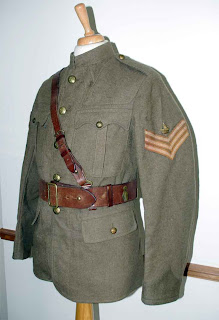The other day I was fortunate to receive a uniform jacket (known technically as Jacket, Service Dress, of a pattern finalised in 1907). A little moth eaten (with holes just beyond the capabilities of the darning needle), the jacket was nevertheless a fascinating object. It spoke volumes.
 The original owner had done everything in his power to alter it to match his status. Equipped with original serjeant's stripes, there were tell-tale holes above that spoke of once-present brass (gilding-metal to purists) crowns that placed the owner as a Staff Serjeant - the most senior of the Non-Commissioned ranks, one down from a Warrant Officer (who would command respect of all, the backbone of the army). Attached were buttons of the Army Service Corps; hardly the glamour of the Guards, the exclusive Yeomanry or dashing Royal Flying Corps, but essential to the war effort nonetheless (providing the transport and the supply chains essential to the army in the field). There is something honest about these simple brass buttons. Staff Serjeant X, a slight man, had had his jacket tailored to a tight fit (a 36" chest if that - very common in the day); he'd had his tailor add cotton shirt material to a collar that now sat high up on his neck, clasped tightly in an Edwardian fashion - no unruly collar points for him. And this dandy had had his pocket flaps shaped to mimic the bespoke-tailored uniform of his Commissioned Officers (produced in the finest barathea), with false cuffs added. Yet this jacket was essentially the same as those worn by his men. Why had he bothered?
The original owner had done everything in his power to alter it to match his status. Equipped with original serjeant's stripes, there were tell-tale holes above that spoke of once-present brass (gilding-metal to purists) crowns that placed the owner as a Staff Serjeant - the most senior of the Non-Commissioned ranks, one down from a Warrant Officer (who would command respect of all, the backbone of the army). Attached were buttons of the Army Service Corps; hardly the glamour of the Guards, the exclusive Yeomanry or dashing Royal Flying Corps, but essential to the war effort nonetheless (providing the transport and the supply chains essential to the army in the field). There is something honest about these simple brass buttons. Staff Serjeant X, a slight man, had had his jacket tailored to a tight fit (a 36" chest if that - very common in the day); he'd had his tailor add cotton shirt material to a collar that now sat high up on his neck, clasped tightly in an Edwardian fashion - no unruly collar points for him. And this dandy had had his pocket flaps shaped to mimic the bespoke-tailored uniform of his Commissioned Officers (produced in the finest barathea), with false cuffs added. Yet this jacket was essentially the same as those worn by his men. Why had he bothered?Uniform style and insignia are codes for all to see but some to read and understand. There were no medal ribbons, coloured stripes for overseas service, or vertical braid to indicate wounding. The jacket gives no extraordinary indications of service in the field. But it does preserve the story of one man seeking to carve out his authority, ensuring that the men under his command knew just who was in charge. Who was he? We will never know, perhaps; what we do know is that this jacket was there, saw service, and demanded respect from all who observed it. It demands the same conditions today.

No comments:
Post a Comment